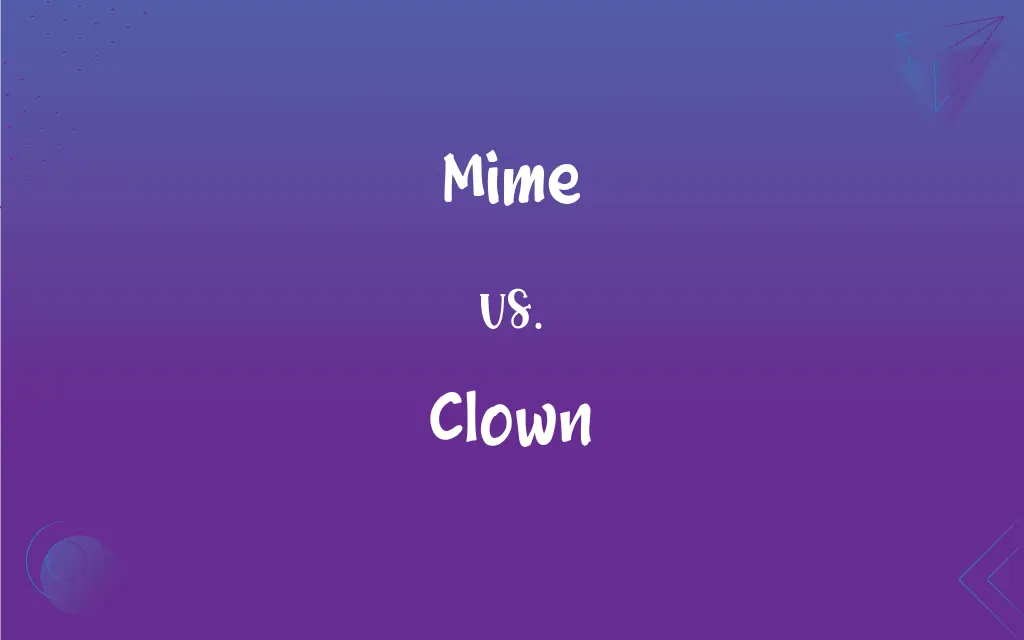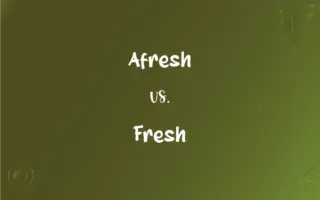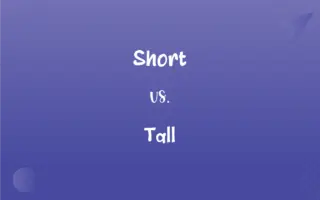Mime vs. Clown: What's the Difference?
Edited by Aimie Carlson || By Janet White || Updated on October 6, 2023
A mime performs silent acts using gestures and expressions; a clown uses comedic acts, often with props, makeup, and spoken words.

Key Differences
A mime is an artist who conveys stories or emotions without using spoken words, relying instead on body movements, gestures, and facial expressions. Originating from ancient Greece, the art of miming grew in popularity, especially in Europe, with performers portraying a wide range of characters, emotions, and scenes without uttering a single word. The objective of a mime is to make the invisible visible, allowing the audience to imagine the objects and scenarios being portrayed.
Conversely, a clown is an entertainer known for their comedic skills, characterized by colorful costumes, exaggerated makeup, and often, the use of props. The history of clowns can be traced back to ancient civilizations like Egypt and China, but they became particularly notable in European circuses. Clowns often interact with their audience, use spoken language, and their primary aim is to induce laughter and joy.
While both mimes and clowns aim to entertain, their methods and styles are distinct. Mimes encapsulate a more abstract form of art, leaning heavily on the audience's imagination and interpretation. Their acts are silent, and the lack of props or elaborate costumes makes their performance minimalistic yet profound. On the other hand, clowns rely on a blend of physical comedy, props, and spoken words. Their colorful attire and playful interactions are tailored for direct amusement.
In cultural contexts, the mime is often seen as a more serious, theatrical form of art, with performers like Marcel Marceau gaining international acclaim. The clown, although equally skilled, is often associated with lightheartedness, circuses, and children's entertainment. However, both have diverse representations and styles across different cultures and time periods.
Comparison Chart
Primary Role
Silent performer using gestures
Comedic entertainer
ADVERTISEMENT
Communication
Non-verbal
Often verbal
Costume/Makeup
Minimalistic
Colorful and exaggerated
Setting
Theaters, streets
Circuses, parties, theaters
Objective
Convey stories/emotions without words
Induce laughter with comedy, props, and interactions
Mime and Clown Definitions
Mime
The theatrical technique of suggesting action or emotion without words.
Her mime of being trapped in a box was incredibly convincing.
ADVERTISEMENT
Clown
Someone who acts in a silly or playful manner.
Stop acting like a clown and focus on your work!
Mime
A communications protocol that allows for the transmission of data in many forms, such as audio, binary, or video.
Clown
A rude or vulgar person (slang).
He behaved like a complete clown at the party.
Mime
A form of ancient Greek and Roman theatrical entertainment in which familiar characters and situations were farcically portrayed on stage, often with coarse dialogue and ludicrous actions.
Clown
A comedic performer, often in a circus, with a brightly colored costume and makeup.
The clown juggled and made everyone laugh with his antics.
Mime
A performance of or dialogue for such an entertainment.
Clown
A performer skilled in slapstick comedy or buffoonery.
The clown's pie-in-the-face routine was a hit.
Mime
A performer in a mime.
Clown
A buffoon or jester who entertains by jokes, antics, and tricks in a circus, play, or other presentation.
Mime
A modern performer who specializes in comic mimicry.
Clown
One who jokes and plays tricks.
Mime
The art of portraying characters and acting out situations or a narrative by gestures and body movement without the use of words; pantomime.
Clown
A coarse, rude, vulgar person; a boor.
Mime
A performance of pantomime.
Clown
A peasant; a rustic.
Mime
An actor or actress skilled in pantomime.
Clown
To behave like a buffoon or jester.
Mime
To ridicule by imitation; mimic.
Clown
To perform as a buffoon or jester.
Mime
To act out with gestures and body movement.
Clown
To krump, especially in clown makeup.
Mime
To act as a mimic.
Clown
A slapstick performance artist often associated with a circus and usually characterized by bright, oversized clothing, a red nose, face paint, and a brightly colored wig.
Mime
To portray characters and situations by gesture and body movement.
Clown
A person who acts in a silly fashion.
He was regarded as the clown of the school, always playing pranks.
Mime
A form of acting without words; pantomime.
Clown
A stupid or badly-behaved person.
Mime
A pantomime actor.
Clown
(obsolete) A man of coarse nature and manners; an awkward fellow; an illbred person; a boor.
Mime
A classical theatrical entertainment in the form of farce.
Clown
(obsolete) One who works upon the soil; a rustic; a churl; a yokel.
Mime
A performer of such a farce.
Clown
A clownfish.
Mime
A person who mimics others in a comical manner.
Clown
To act in a silly or playful fashion.
Mime
Any of various papilionid butterflies of the genus Chilasa or Papilio, that mimic other species in appearance.
Clown
To ridicule.
Mime
A unit of imitation in the theory of symbiosism.
Clown
A man of coarse nature and manners; an awkward fellow; an ill-bred person; a boor.
Mime
To mimic.
Clown
One who works upon the soil; a rustic; a churl.
The clown, the child of nature, without guile.
Mime
(intransitive) To act without words.
Clown
The fool or buffoon in a play, circus, etc.
The clown shall make those laugh whose lungs are tickle o'the sere.
Mime
To represent an action or object through gesture, without the use of sound.
In this game, you're given a word, which you have to mime to the others in the group.
Clown
To act as a clown; - with it.
Beshrew me, he clowns it properly indeed.
Mime
A kind of drama in which real persons and events were generally represented in a ridiculous manner; an ancient Greek or Roman form of farce.
Clown
A rude or vulgar fool
Mime
An actor in such representations.
Clown
A person who amuses others by ridiculous behavior
Mime
The art of representing actions, events, situations, or stories solely by gestures and body movements, without speaking; pantomime{3}.
Clown
Act as or like a clown
Mime
An actor who performs or specializes in mime{3}; an actor who communicates entirely by gesture and facial expression; a pantomime{2}; a pantomimist; a mimer.
Clown
An individual making fun or trying to be amusing in a clumsy manner.
She's always the clown in class, making everyone giggle.
Mime
A mimic.
Mime
To mimic.
Mime
An actor who communicates entirely by gesture and facial expression
Mime
A performance using gestures and body movements without words
Mime
Imitate (a person, a manner, etc.), especially for satirical effect;
The actor mimicked the President very accurately
Mime
Act out without words but with gestures and bodily movements only;
The acting students mimed eating an apple
Mime
A performer who uses gestures and movements without words.
The mime acted out a heartbreaking story of loss on the street corner.
Mime
A form of ancient Greek drama using mimic gestures and no dialogue.
The theater group specialized in classic mime performances.
Mime
To imitate or mimic actions, often in a comedic manner.
She would mime playing a guitar whenever her favorite song played.
Mime
A silent actor who tells a story using body language.
The audience was captivated by the mime's portrayal of the wind and the leaves.
FAQs
Is miming a modern art form?
No, miming dates back to ancient Greece and has evolved over time.
Do mimes always perform silently?
Yes, mimes traditionally use gestures and expressions without speaking.
Do clowns always wear makeup?
Most do for performances, using exaggerated makeup to amplify expressions.
Is mime only a Western art form?
No, while popular in the West, miming or silent performance exists in various cultures.
Why do clowns wear bright costumes?
The vibrant attire draws attention and enhances their comedic persona.
Are clowns always found in circuses?
While common in circuses, clowns can also be at parties, events, or theaters.
Can a mime use props?
While traditionally minimalistic, some mimes might use select props for emphasis.
Can someone be afraid of clowns?
Yes, coulrophobia is an irrational fear of clowns.
Is a jester the same as a clown?
They share similarities, but jesters historically entertained royalty, while clowns have broader audiences.
Do mimes always wear striped shirts?
No, while iconic, mimes can wear different outfits, but usually stick to simple attire.
Are there schools for clowning?
Yes, there are institutions dedicated to training individuals in clown arts.
Do clowns always have a red nose?
While iconic, not all clowns wear a red nose.
Are there different types of clowns?
Absolutely, including comedic, whiteface, and rodeo clowns, among others.
Can mime be a form of street art?
Absolutely, many mimes perform on streets, entertaining passersby.
Can a clown act be dramatic instead of comedic?
While rare, some clowns might incorporate drama into their acts.
How long does it take to learn miming?
It varies, but mastering mime can take years of practice and dedication.
Can miming be a form of therapy?
Yes, some therapists use mime techniques to help patients express emotions.
Do mimes speak at all during a performance?
Traditional mime acts are silent, but modern interpretations might include minimal speech.
Is there a universal clown costume?
No, clown costumes vary widely, but often include bright colors and exaggerated features.
Do mimes always perform solo?
While many do, mimes can also perform in groups or duos.
About Author
Written by
Janet WhiteJanet White has been an esteemed writer and blogger for Difference Wiki. Holding a Master's degree in Science and Medical Journalism from the prestigious Boston University, she has consistently demonstrated her expertise and passion for her field. When she's not immersed in her work, Janet relishes her time exercising, delving into a good book, and cherishing moments with friends and family.
Edited by
Aimie CarlsonAimie Carlson, holding a master's degree in English literature, is a fervent English language enthusiast. She lends her writing talents to Difference Wiki, a prominent website that specializes in comparisons, offering readers insightful analyses that both captivate and inform.































































